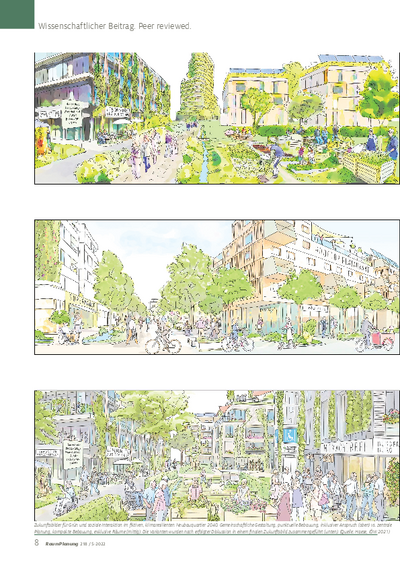Future visions for green and climate-resilient neighborhoods Reflection on potentials and limits using the example of future vision processes in the project “Green City of the Future"
The effects of climate change influence everyday life in our cities. This is evidenced by the increasing occurrence of heavy rain events, droughts and heat stress. This can lead to devastating consequences for people and the environment. It poses significant challenges, especially for growing cities, both now and in the future. These cities are simultaneously confronted with increasing structural density and social inequalities.
The article "Future visions for green and climate-resilient neighborhoods" is dedicated to the question, what future visions can contribute to the development of green and climate-resilient neighborhoods in order to meet the upcoming challenges. Thereby it is part of the thematic focus "Climate Adaptation in Municipalities" of the magazine ‘RaumPlanung’. The basis for answering the posed question are findings from three vision processes in the "Green City of the Future" project. This focused on the City of Munich. Here, the task was to show various design options for green and climate-resilient neighborhoods and to promote the participatory development of solutions for neighborhoods worth living in. This should go beyond the personal concerns of actors involved in the processes from planning practice, the housing sector, civil society, local politics and trade.
The focus of analysis of future visions in this article are the functions of knowledge formation, communication, goal setting as well as decision making and strategy formation. This is illustrated by using individual examples from the project. Also reflected are differences in the assessment of potentials and limits of the method by different stakeholder groups. The starting point for this is the evaluation of project activities as well as guided reflection interviews with individual participants in the project.
From the perspective of transformative research, a possible added value of the vision method is the support that is necessary to have changes in the development of green, climate-resilient neighborhood. The same refers to the promotion of the planning and implementation of concrete measures.
The article ends with conclusions for the development of green and climate-resilient neighborhoods. For example, future visions offer a substantial as a method added value if they are embedded in concrete planning processes or ongoing expert discourses. This applies for the city, neighborhood or building level. Here similarities and contradictions in the perspectives of individual actors and groups of actors can be worked out at an early stage. Also, future visions can sensitize the general public for various design options and create acceptance for needed change.
For the complete edition, including the option to order printed copies



